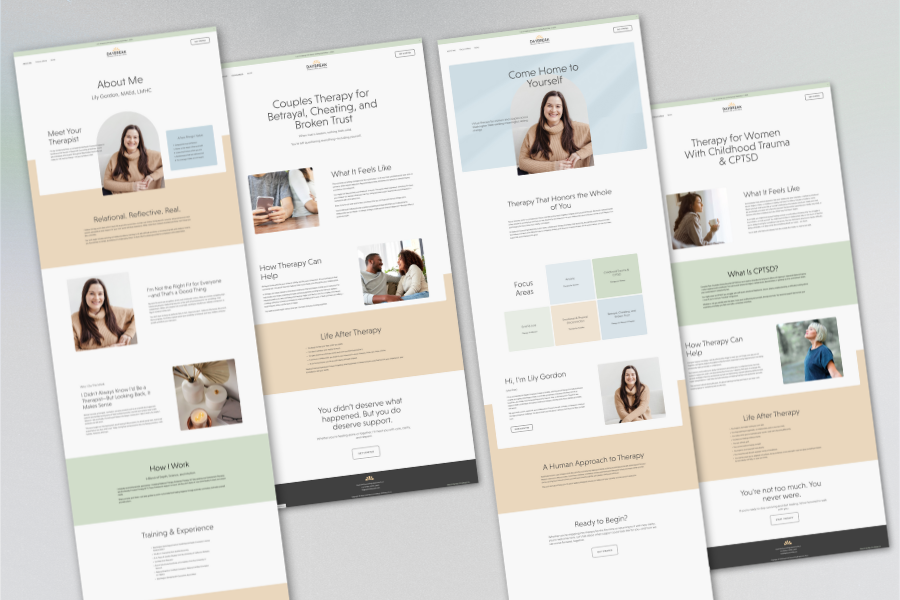How to Attract Dream Clients With Your Website
A common concern I hear from both new and seasoned therapists is that they don’t want to look arrogant or sales-y when trying to engage potential clients and referral sources through their website. Also, nearly everyone I’ve consulted with had convinced themselves that it was risky to work within a specific niche because it limits their pool of potential clients.
So, they focused their website on attracting everyone. They felt pressure to cast a wide net. They cut themselves off from making the leap to a smaller niche.
Guess what happened?
Yep, they didn’t attract their favorite clients at all. Moreover, because they didn’t get ideal clients, this validated their belief that there weren’t enough of their ideal clients weren’t out there.
If your website isn’t set up to attract your dream clients, then it’s probably set up to repel them.
Therapists respond by lowering their fees, getting on insurance panels, and widening their audience in the hope of getting some business. The "wide net and low fees" strategy ultimately creates an unfocused marketing approach and hides therapists behind lifeless websites that don’t speak to anyone at all.
When you focus on proactively attracting specific, ideal clients to your practice, you stop worrying about pleasing everyone and get consistent business - without begging!
Here are some of my favorite ways to not only keep people coming to your website but also targets the right type of clients.
1. Describe Your Ideal Client in Vivid Detail
If you know who you want to work with, you can build a strategy that targets them directly. Grab a pen and write the answers to these questions:
What kind of client do you wish you could work with every single day? Male or Female? What is their occupation? What do they like to do on the weekends? How many kids do they have? What are their hobbies and interests? What kinds of movies do they watch and what books do they read? What brands do they love? What is their NAME?
However, knowing that much isn’t enough. You need to go much deeper than that and identify your ideal client’s pain points.
In what ways are they challenged? What is their family history? Which areas of their life affected? What are their relationships like? What kind of suffering are they familiar with?
Get very detailed. Then use your answers to help pinpoint who your dream client is and build your website around that person exactly.
If you have already defined your ideal client, that’s great! You can move on to the next steps. If you haven’t, stop right now and DO it. If you’re serious about attracting clients you want to work with, then you need to define precisely who that is.
2. Identify How You Will Serve Your Ideal Clients
More than anything, your potential clients want to know that you can help them. They also want to know about your process. Showing your services on your home page is a great way to keep your website visitors on your site. Once you’ve crafted your message statement, place it where people can see it. Usually, this is front and center on your home page. Your services should be organized, easy to understand, and speak right to your ideal client.
Some basic examples:
Individual Therapy and Coaching for Artists and Creative Entrepreneurs
Mindfulness-Based Therapy and Support Groups for Busy Moms
Addiction and Recovery Services for Young Adult Men with Substance Use Disorders
Walk and Talk Therapy for People Who Want to Feel Like They’re Moving Forward
Give it your spin and personality to sound less generic and more unique.
I see many websites without a statement like this, so I’m left looking around to see what they’re offering. Usually, by that point, I go. I imagine that most visitors will do the same.
Don’t worry that your message will send people away. That’s the idea! You want your message to attract the right people and repel the wrong people.
3. Write Your Copy Strategically
Think about what your client might be thinking as they are looking for a therapist. Are they feeling cautious about calling you? Probably. Are they dealing with relationship issues? Do they have concerns about body image? Are they struggling with parenting their teen? In what ways are they feeling stuck? Your potential clients need to know that you understand what they are going through and what they need.
Your website can be the very thing a potential client needs to make that call; to initiate the uncertain and terrifying process of going to a therapist. Here are tips for writing your copy strategically so that your dream client will call you right away:
Talk to one person, not a nameless crowd.
Use your voice and write in a conversational tone, as if you’re having a friendly conversation with your ideal client.
Remove psychobabble, jargon, cliches, a preachy tone, and other things that dehumanize your writing. For example, therapists love to talk about their credentials, certifications, and theoretical approaches not realizing that most people don’t know what any of that means.
Share a personal story (that isn’t so personal that you’d feel uncomfortable if a client brought it up).
Write in the first person (I) and not the third person (she). Second person (you) is even better because you want most of your copy to focus on your ideal client.
One of my biggest pet peeves is when therapists speak about themselves in the plural (“We provide X services”) when there is only one therapist in practice.
Here’s the harsh truth: People don’t read websites, they scan them. To help your ideal client get the most out of your writing, you need to make it scannable and readable.
Check your grammar and spelling. A few mistakes make you human. Many mistakes make you seem uneducated or lazy. I use Grammarly to check my writing.
Make it easy to get in touch. Use a contact form or place your phone number on every page. Don't provide several ways to get in touch - this leads to clients feeling nervous about which contact method is the best one.
Don’t hide your rates. Showing your rates means you’re a legit, trustworthy person who has nothing to hide.
Respect your readers and make writing as human-friendly as you can. If you can’t do it, hire someone to do it for you. (I offer Writing Assistance with one of my website packages.)
4. Become a Search Engine Ninja (It’s Easier Than You Think).
You don't have to be an expert in SEO to learn how to attract the right clients. Here are my tried-and-true SEO tricks you can implement today:
Use keywords that your ideal clients may use to find your practice, and organically place them through your website.
Label your page titles and descriptions. Search engines use these when ranking your website.
If your platform has an SEO section within its settings be sure to fill this section out.
Label all images. Google won't pick up "IMG_238923," but it will pick up a label that is relevant.
Utilize Google Analytics. It's a free service that collects data to help you get to know more about your website visitors and their behaviors. Understanding the data behind your web traffic is an essential step to analyzing what works and what doesn’t.
5. Design a Beautiful, Modern Website
It might sound simple, but you’d be surprised by how many therapist websites I see that look like they’re from 1997. Is your website design something your ideal client would be attracted to? Nowadays, there’s no reason to have a lousy site, even if you aren’t a designer.
As much fun as it is designing your site, you must think about what will attract your ideal client. I always wonder how often female web designers with pink colors and script fonts all over their website attract male clients.
Here are a few additional tips for attracting your ideal clients through your website design:
Your site should be simple to navigate and clear. Ugly, cluttered, and confusing design can turn people off in no time, no matter how great your content is. I recommend a minimalist WordPress or Squarespace theme and keeping things simple. (I make all my websites on Squarespace.)
Colors and images play a critical role in attracting the right client. Choose pictures that look good with your colors and draw your ideal client by invoking the right emotion. Be sure to display relevant people or objects.
Take us behind the scenes. A lovely photo of you and your (clean and tidy) office makes clients feel welcome before they’ve even stepped foot in your office.
Don’t use stock photos that look like stock photos. Don't use pictures that are overused on therapy websites. You know what I mean:








































